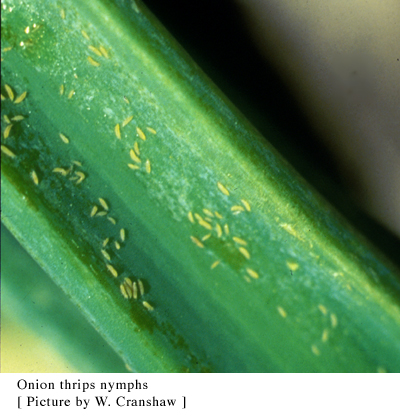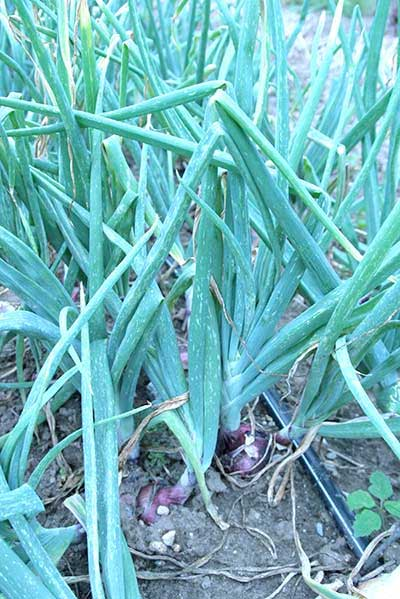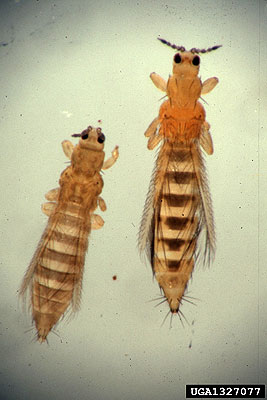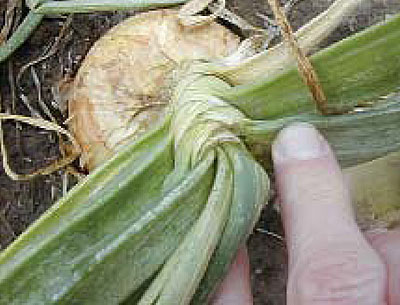
Pest: Onion Thrips (Thrips tabaci)
Pest/disease Identification and lifecycle, most common symptoms and crops affected:
Onion thrips are active already, and if they have been a problem for you in years past it is time to start scouting for them. They are very tiny and easily overlooked until the onion plants start showing leaves that look as if they have been rasped. In fact they have. The thrips feed by using their mouth parts to rasp and pierce the onion leaves, releasing juices for them to feed upon. If the population of thrips is large, you will see silvery patches on all the young leaves. When it is really bad, the whole field will look white and silvery and the leaves will wither. Obviously onion yields can be greatly reduced because the onion plant loses food and water through the damaged tissue. It is best to get control of them before their populations grow.
Onion thrips hide between the leaves at the base of the onion plant. The best way to find them is to pull up a plant and hold it upside down over a white sheet of paper and pull apart the leaves as you shake gently. Even when they are walking about on the paper you will still need to look hard to see the thrips. Magnification such as a hand lens is very helpful to spot them. Immature thrips are white to a pale yellow, elongated in shape, but tiny, with very short antennae and dark eyes. The adult is tiny too, but it has wings. Thrips’ wings are unique. They are fringed with hairs. Thrips are very poor fliers, but they do fly when disturbed, and they do get blown in the wind easily, so they may move long distances. Keep in mind that this means thrips can be blown to new fields downwind. Adults are pale yellow to dark brown. There are many generations per season and they can reproduce very quickly in warm weather. Also, parthenogenesis is common, meaning females that cannot find males can reproduce all by themselves. Each female can produce up to 80 eggs, which tells you that the population can explode quite quickly under good conditions. Good conditions are warm and without heavy rains.
Management options:
Cultural:
Heavy rains wash the weak insect off the plant. Growers can simulate heavy rains with heavy overhead irrigation. As well as disturbing the insect, the extra water will help the rasped onions. Extra fertilization will help too.
Thrips survive in onion and garlic debris so clean up after harvest. Also, thrips can overwinter in garlic bulbs, so you may have “planted” them when you planted garlic in the fall. Some say that thrips are confused by intercropping with carrots, and have a harder time finding your crop.
Pesticides approved for use in certified organic production (as a last resort):
If natural enemies or cultural practices fail to keep thrips populations down then you may need to turn to a pesticide. Remember, thrips are often around in small numbers which can be tolerated. Integrated pest management (IPM) practices recommend an economic threshold of an average of one thrips per green leaf. When scouting, sample about 50 plants from at least 10 different locations in the field and then figure the average per leaf. Spinosad is the most common recommended material (Entrust is the most common brand for commercial growers). Follow the label instructions and be sure to spray into the leaf axil. Surround (kaolin clay) is reported to deter thrips, and may be a good prophylactic decision if you have had bad thrips problems in the past. See this excellent article about onion thrips by Tom Vigue.
Please note: This information is for educational purposes. Any reference to commercial products, trade or brand names is for information only, and no endorsement or approval is intended. Pesticide registration status, approval for use in organic production and other aspects of labeling may change after the date of this writing. It is always best practice to check on a pesticide’s registration status with your state’s board of pesticide control, and for certified organic commercial producers to update their certification specialist if they are planning to use a material that is not already listed on their organic system plan. The use of any pesticide material, even those approved for use in organic production, carries risk — be sure to read and follow all label instructions. The label is the law. Pesticides labeled for home garden use are often not allowed for use in commercial production unless stated as such on the label.
Informed by: Eric Sideman




